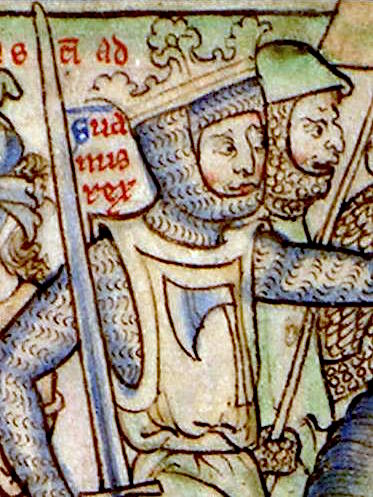Within the depths of medieval history, one name stands out among the rest as a testament to the might and fortitude of the Viking people. Sweyn Forkbeard, the first Viking king of England, was a warrior with no equal and a figure whose legacy lived on for centuries.
His life was marked by adventure, danger, and treachery. He fought many enemies on the field of battle and navigated the treacherous waters of medieval politics. From Denmark, his homeland, to the northern reaches of Norway and Scandinavia, across the sea to England, and the many kingdoms there, Sweyn Forkbeard would leave his mark.
The story of Sweyn Forkbeard – the first of his name and the first Viking king of England – is a tale of bravery and heartbreak, conquest, and violence.

Sweyn’s Royal Heritage
As is often the case with all but the most famous of Vikings kings and warriors, the sources and information on Sweyn Forkbeard are fragmented, inconsistent, or lost to historical records.
However, it is widely accepted that the legendary figure was born circa 960 AD and was the son of Harald Bluetooth, the King of Denmark. Still, historical accounts regarding Sweyn’s lineage remain somewhat inconsistent.
One source claims that he was instead the son of Harald’s older brother, Knut Danaást, and Tove, and was born after Knut died in battle. Tove subsequently married Harald, who raised Sweyn as his adopted son.
Another account suggests that Sweyn was the son of Gunhild and Harald and was baptized as Otto following Harald’s conversion to Christianity. Despite these discrepancies, Sweyn’s heritage as a member of the Danish royal family is unquestionable.
Seizing the Danish Throne
Sweyn Forkbeard was ruthless and filled with ambition. This became evident when he forcefully seized the throne of Denmark from his father, Harald Bluetooth, in the mid-980s.
Together with his close ally, Palnatoke – a Danish hero in his own right – Sweyn launched a violent campaign that culminated in Harald’s deposition and exile to Germany. His father likely died not long after. Sweyn’s ascent to the Danish throne in 986 marked the beginning of his reign as a powerful Viking leader.
While the circumstances surrounding the rebellion against his father remain unclear, Sweyn’s actions demonstrated his cunning and his willingness to use force and violence to get what he wanted – even against his family.
Sweyn Feuds with King Olaf of Norway
Sweyn’s thirst for power and conquest knew no bounds. After establishing himself as the king of Denmark, he began to look towards neighboring Norway, where Olaf I had recently ascended to the throne.
Sweyn saw Olaf as a rival and a threat to his power, and thus their feud began brewing around the year 995. In hopes of bringing Olaf’s reign to its knees, Sweyn began constructing a powerful alliance with the Swedish king Olaf Skötkonung, and the Norwegian Earl of Lade, Erik.

The alliance was fueled by various reasons, including Olaf’s marriage proposals to Sigrid the Haughty and Thyri, Sweyn’s sister. According to the sagas, Sigrid’s anger and manipulation played a role in convincing Sweyn to wage war against Olaf.
Undoubtedly, however, the success of the prevailing alliance can be mostly attributed to Sweyn’s shrewd military tactics and exceptional leadership skills, which he proved many times over.
Victory at the Battle of Svolder
In the year 1000, Forkbeard and his new allies – Olaf of Sweden and Erik of Norway – defeated King Olaf I of Norway in the Battle of Svolder. This marked a significant turning point in Scandinavian history. Sweyn emerged as the virtual ruler of Norway. While nominally sharing sovereignty with his allies, he remained in charge.
The Viking battle must have been glorious to behold. In the end, Sweyn regained direct control of the Viken district while King Olaf of Sweden received four districts in Trondheim, among a few others.
The rest of Norway was ruled by Eirik Hákonarson as King Sweyn’s vassal. However, Sweyn would be considered the King of Norway for more than a decade.
Although Christianity was adopted during their reign and control of the Norwegian territories, religious freedom was allowed. This led to a backlash against Christianity that undid much of Olaf I’s prior missionary work.
Sweyn’s crushing victory at the Battle of Svolder was a testament to his military prowess and established him as the most powerful ruler in Scandinavia, now King of Denmark and Norway. His eyes quickly turned towards the lands beyond the North Sea.
Sweyn Forkbeard’s Invasion of England (And a Short-Lived Reign)
Between the time of Sweyn’s growing feud with Norway’s Olaf I and his subsequent triumph at Svolder, the Vikings of Denmark had been busy across the North Sea already. They conducted many raids across Devon and Kent in the intervening years.
After his sister Gunhilde and dozens of other Danes were killed in the St. Brice’s Day massacre of 1002, Sweyn was finally consumed with a desire for revenge against the English King Æthelred.
In 1003, Sweyn led a large invading force to England, unleashing unprecedented pillaging and plundering that brought immense devastation to the English populace. Exeter, Wiltshire, Hampshire, and East Anglia were all decimated by Sweyn’s Viking forces. Æthelred once again paid off the Danes to gain respite for his people, but the raids continued on and off until 1013.
Sweyn returned to England in 1013 – this time in full force. Sweyn and his men rampaged across the English countryside, taking Northumbria and the Danelaw, before causing the English resistance to crumble at Wessex.
He was proclaimed king throughout the country, forcing King Æthelred into exile. The English earls declared Sweyn king on Christmas Day, but shockingly, his reign would only last a few weeks before his sudden death in February 1014 at his capital in Lincolnshire.
Despite his short-lived reign, Sweyn’s empire continued under his son and grandson until 1042. And though his body was later removed to Denmark to be put to rest in his homeland, Sweyn Forkbeard’s Anglo-Danish legacy endured for decades to come.
References
Johnson, Ben. “Sweyn Forkbeard, King of England.” Historic UK, https://www.historic-uk.com/HistoryUK/HistoryofEngland/Sweyn-Forkbeard/.
McKenna, David. “Sweyn Forkbeard: England’s Forgotten Viking King.” BBC News, BBC, 25 Dec. 2013, https://www.bbc.com/news/uk-england-lincolnshire-25341754.
Sweyn Forkbeard the First Viking King of England.” Discover Middle Ages, Discover Middle Ages, 3 Feb. 2016, https://www.discovermiddleages.co.uk/kings-and-queens/king-sweyn-forkbeard.
“Sweyn I.” Encyclopædia Britannica, Encyclopædia Britannica, Inc., 30 Jan. 2023, https://www.britannica.com/biography/Sweyn-I.

